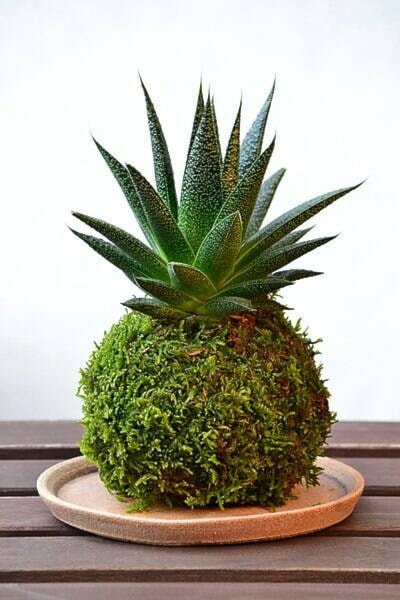Kokedama, translates into moss ball, a Japanese art form. It is a plant potted into a ball of soil that is covered by moss. The plant is then displayed in a dish container or suspended by string.
Making a Kokedama is easy, keeping it alive is more difficult.
When making a Kokedama, choose a small plant that is easy to grow, drought-tolerant and meets the light requirement of its environment.
To turn a potted plant into a Kokedama, a peat-based potting soil, sphagnum moss, thin floral wire, wire staples, water and string are needed
Start by wetting the soil until it forms a mud ball. Then remove the plant from the pot brushing away all the excess soil.
Break the mudball in half and sculpt it around the roots of the plant. Keep adding soil until the plant’s roots are completely enclosed.
Set the ball aside and spread the moss out on a flat surface. If the moss is in a large piece, all the better.
Gently place the root ball into the center of the moss and bring the moss up to cover all the root ball. Metal staples are used to hold the moss in place each step of the way.
Make sure all areas are covered with moss before wrapping the ball in with wire. Start by encircling the rootball once and twisting the end into the wrapping wire. Then wrap as many times as needed and in the directions needed to keep the moss and soil intact.
The next steps are optional. Wrapping it in a string, and making a hanger for the Kokedama.
Wrapping the string is completed in the same manner as the wire.
The simplest way to hang the ball is to cut the string at the desired length and knot it in the middle. Attach the string to the moss ball with a staple in the center of the bottom of the ball. Bring the strings around all sides of the ball, attaching them at the sides with a staple. Tie a knot at the top and hang the plant.
To display the plant in a bowl or tray, line the container with pebbles to create an airflow under the plant. If the rootball sits on a solid surface it is likely to mold.
Caring for a Kokedama is different from a plant in a plastic or clay pot. In a pot when the roots reach the edge, they circle around the pot. In a Kokedama the roots meet air and stops growing in that direction.
Expect to water more often than a potted plant because the moisture evaporates from all areas of the rootball, not just the top of the soil.
To water, submerge the ball in water for 5 to 10 minutes. Take it out and either hang it over a drain or sit it in a colander to allow excess moisture to drain away before hanging it back up or putting it in its bowl.
Fertilizing is as simple as adding a water soluble fertilizer to the soaking water.
Like all plants, Kokedama will outgrow their container. At this time the plant can be potted up or placed in a bigger moss ball.
Linda Tomlinson has gardened in Central Alberta for over 30 years. She can be reached at your_garden@hotmail.com.
